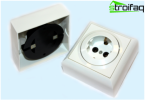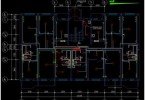The energy consumption needed to service a huge number of devices that make our lives easier is increasing day by day. The abundance of wires, cables, sockets, switches and fuses must not only be placed somehow, but also maintained in good condition. In addition, the old wiring often does not withstand new increased loads, as a result of which it becomes necessary to completely replace it. Not everyone in this case can do without a qualified electrician – with your own hands without the skill to make a replacement is not easy. To many, such work seems difficult, although this is just a fallacy. In this article we will try to give all the necessary information so that you can perform at least the simplest electrical work yourself.
Content
- Competent preparation for work
- Replacing old wiring
- How to pick up wires
- Open or hidden way?
- Wire Connection Rules
- Common faults
- Damage exclusion requirements
- How to troubleshoot
- Safety Precautions for Electricians
Competent preparation for work
If you are interested in how to make electrical wiring with your own hands, then you need to draw up as detailed a scheme as possible with an accurate indication of all sizes and locations of electrical points. To do this, you need to have some knowledge from the school physics course, as well as familiarize yourself with the Electrical Installation Rules (PUE) in order to prevent mistakes in design. What else will be needed at the initial stage?
- The electrical circuit of all wiring in the home.
- Understanding the basic principles of electrical equipment.
- Knowledge of minor troubleshooting methods.
- Information on the main types of wires and their characteristics.
- Tool Skills.
If you live in a private house, then, most likely, an executive wiring diagram located in your document archive. If you are the owner of the apartment, then you can get it either in a REU or a housing department, or make it yourself (maybe it will be faster). When making significant changes to an existing plan, remember that they will have to be coordinated with the appropriate authorities..
Replacing old wiring
Let’s start with such a complex and most labor-intensive process as replacing wiring with your own hands.
How to pick up wires
To determine the desired wire cross-section, it is necessary to calculate the total load on the network while turning on all consumers. For every kilowatt of power, 0.5 sq. Mm is allocated.

The desired cross-section of wires can be selected from this table
It is better to buy a stranded copper wire, it is much more elastic than its “competitors” and can withstand very large loads. In residential areas where the use of powerful appliances, such as an electric stove, is not planned, it is enough to purchase a three-wire VVG wire with a cross section of 1.5 mm for lighting and 2.5 mm for voltage supply. For high-power devices, you will need a wire with a cross section of up to 4 sq. Mm.
Open or hidden way?
There are hidden and open wiring. Since the installation of open electrical wiring is almost the same process as the installation of hidden, with the exception of laying the cables in special channels, we will consider just the last case.
You can, of course, hide the wiring by applying a layer of plaster on it, but it will be much more aesthetic to hide all the wires in the channels arranged in the walls.
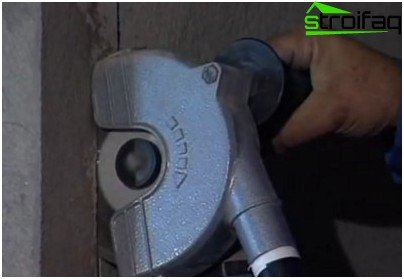
Before strobing the grooves, we outline the lines with a grinder
To do this, a wiring diagram is applied to the walls, and along the drawn lines (by the way, they should be located only vertically or horizontally, as well as their intersection is extremely undesirable), a groove is cut using a grinder. Then, with the help of a puncher, strobes with a depth of 15-20 mm are selected on it. A special nozzle is used to select holes for the outlet, but you can do without it. In this case:
- the center of the outlet is marked;
- holes are drilled around the planned perimeter;
- the area between them is knocked out with a chisel.
The wiring in the channel is fixed with special plastic clamps, and the sockets are installed on the alabaster.
Tip: when installing the socket, do not forget to leave the margin necessary to level the wall with putty.
Wires are laid along the finished channels from the outlet to the junction box and from the switch to the junction box through the lamp. Each power distribution box should have one power cable. After that, the wires are switched.
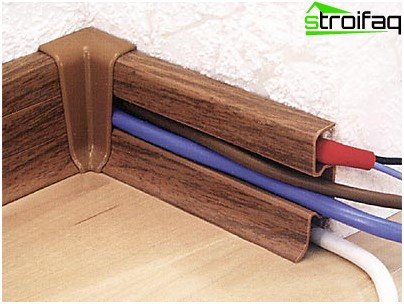
Hidden wiring can be done in baseboards
Hidden wiring can be placed not only in the walls, but it can also pass inside the baseboards or in special overhead boxes. This allows for further operation to quickly detect a malfunction and eliminate it. To prevent a short circuit or open circuit, you need to know
Wire Connection Rules
First, we carefully clean both ends to ensure a tight contact. Next, we gently twist and solder it with a very heated soldering iron, but with a universal flux, in order to avoid excessive heating of the insulation, which leads to its rapid wear. All sharp corners of the contact wires must be blunted so that they do not pierce the insulation..
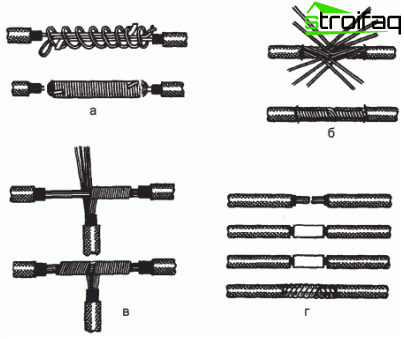
Methods for connecting stranded wires
Tip: It is better to buy wires so that the core of one purpose matches a certain color. For example: phase is a red wire, zero is blue, and grounding is green. In the future, it will be easier to attach to each other.
After connecting the wires, apply voltage to the junction box and check its presence in outlets using an indicator and the operation of the lamps. Now you can start decorating the room.
Common faults
It is not always necessary to replace electricians. Sometimes you need a simple line repair. The quality of our power grids is still poor. Therefore, even if the wiring is laid in accordance with all the rules and standards, frequent power surges capable of causing various damage to it.
Also, their appearance can be caused by connecting inoperative devices to the network, as well as by a delay in the operation of protective devices or their malfunction. We will analyze the main malfunctions of electrical circuits.
- Sparking wires. It occurs when the circuit under load is opened, if the wires and cables are not well connected to each other, as well as during breakdown of insulation between two conductors.
- Overload. This malfunction can also cause a fire, since in this case a current with a rating higher than the permissible norm flows through the wires, which leads to their heating. As a result, the insulation of the conductors may ignite. Even if the heating is insufficient to ignite, the insulation from it wears out faster. Overload occurs while simultaneously connecting a large number of consumers to the network, increasing the room temperature or improperly selected wires. In rare cases, lightning strikes or other currents entering the conductor are the cause of the overload.
- Short circuit. This is the name of any short circuit between wires, or between wires and ground. It occurs as a result of a violation of the integrity of the insulation as a result of damage, aging or increased voltage in the network.
Damage exclusion requirements
Neither a short circuit, nor an overload, or other troubles can ever happen at all, if during do-it-yourself wiring, observe a few simple requirements:
- Not just twist the wires together, but be sure to connect them by welding, soldering or crimping.
- Do not abuse the parallel connection of electrical points.
- Install all necessary safety devices with quick response..
- Use only conductors with sufficient cross-section..
- Use only circuit breakers or fuses.
How to troubleshoot
Subject to safety rules, repairing electrical wiring with your own hands is quite easy. So there is no light in the house. What to do? First you need to make sure that there is voltage in the electrical panel. This is determined using the tester indicator, which must be in the list of tools of the landlord. If it shows that there is tension, then the problem arose only for you. Otherwise, the first thing we turn off the machine on the counter and turn it on again. If the cause of the lack of electricity was a power surge, then this should help.
Didn’t the light come on? So, everything is much more tragic. Most likely, there was a break in the wiring as a result of mechanical damage or overload in the network. It will be more difficult to find this place when the hidden wiring is torn or if the wire is in plastic insulation. To detect, you need an ohmmeter, or an vernacular probe. Two probes of this device are applied to the wire and according to its indications determine the place of damage. The main rule of working with an ohmmeter is the de-energization of the wiring. If you are still not confident in your abilities or have absolutely no idea which way to approach the probe, it is better to invite a professional electrician who will quickly detect a malfunction.
After finding the place of the gap, it must be carefully opened and the identified problem fixed, observing all safety rules.
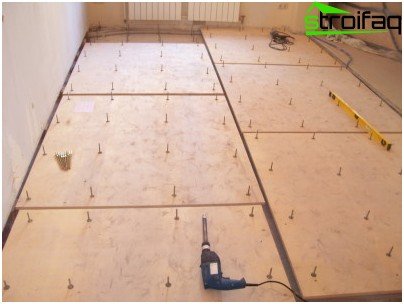
After finding the place of the gap, the section must be opened and the fault eliminated.
Safety Precautions for Electricians
There are several rules that must be observed during any work with electricity:
- The electric network, in which the work is planned, must be disconnected.
- The handles of the entire tool must be insulated..
- If the switchboard is located in public places (for example, on the landing), a warning sign on line operation must be hung up..
- Before starting work in the absence of voltage must be verified using special devices.
- With junction boxes, grounding, protection devices, meter and input voltage, only qualified electricians should work.
When working with electricity, remember that neglect of safety precautions and the requirements of PUEs can lead not only to a quick failure of the electrical circuit, but also, more frighteningly, to significant damage to the human body and even death.


